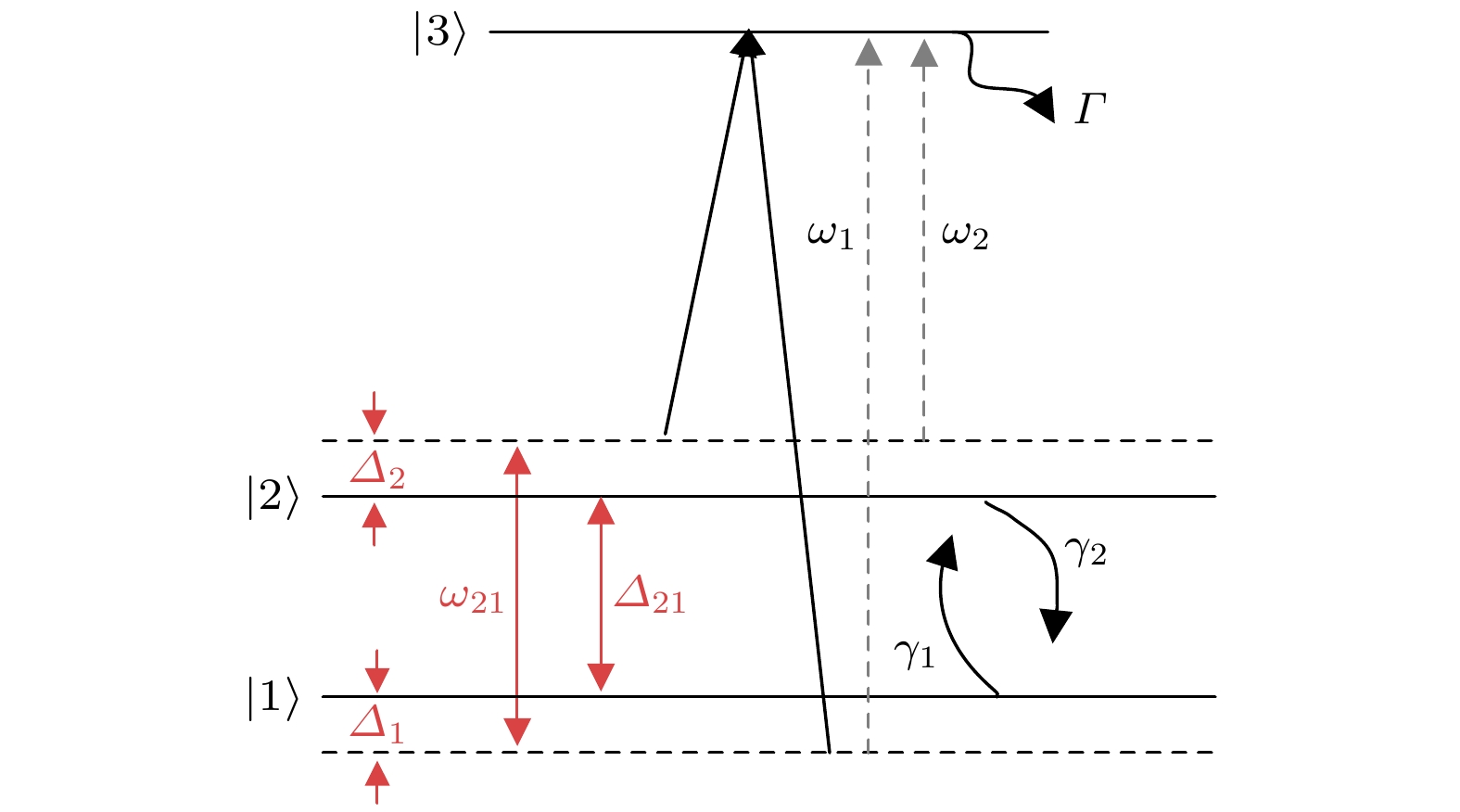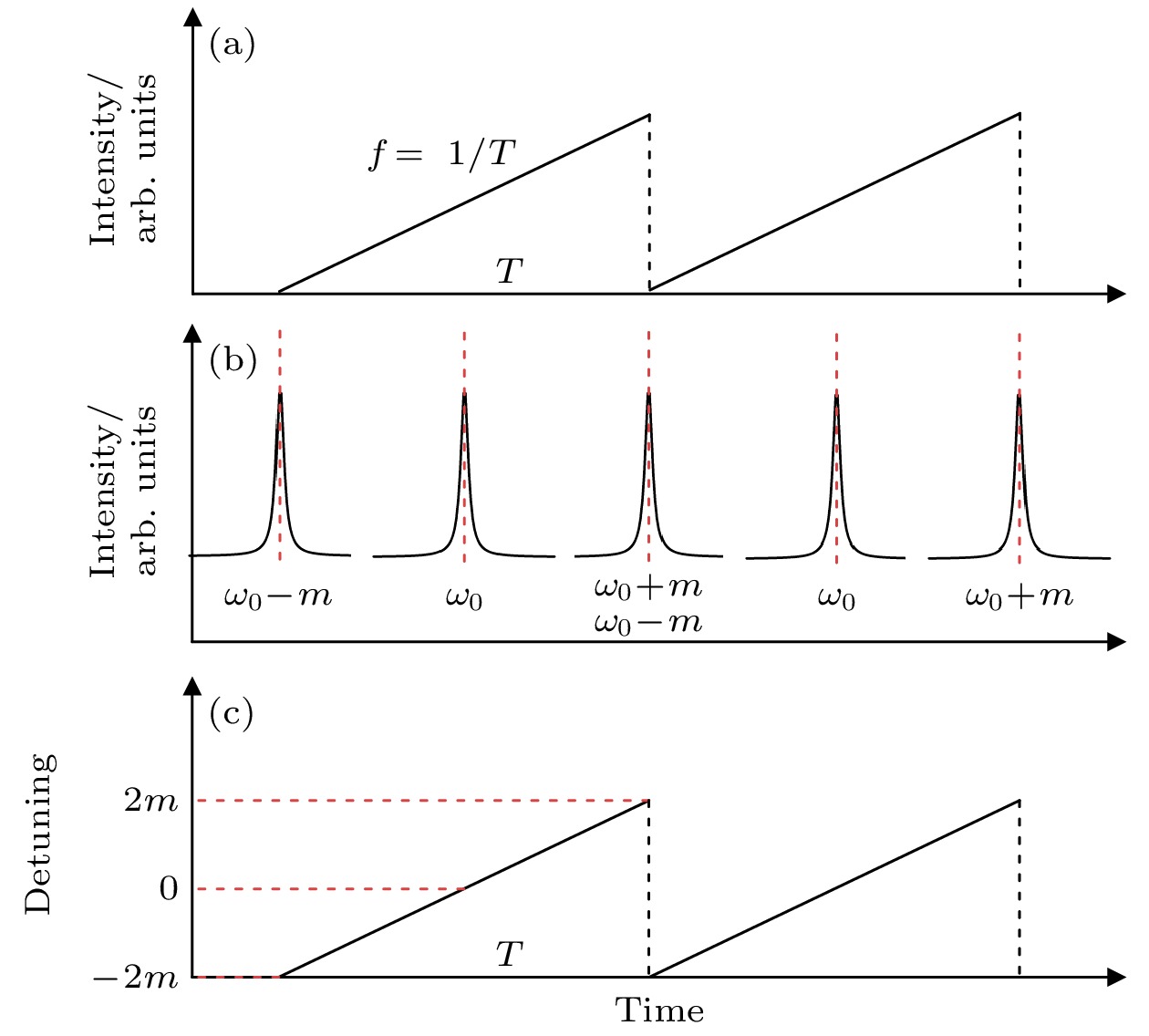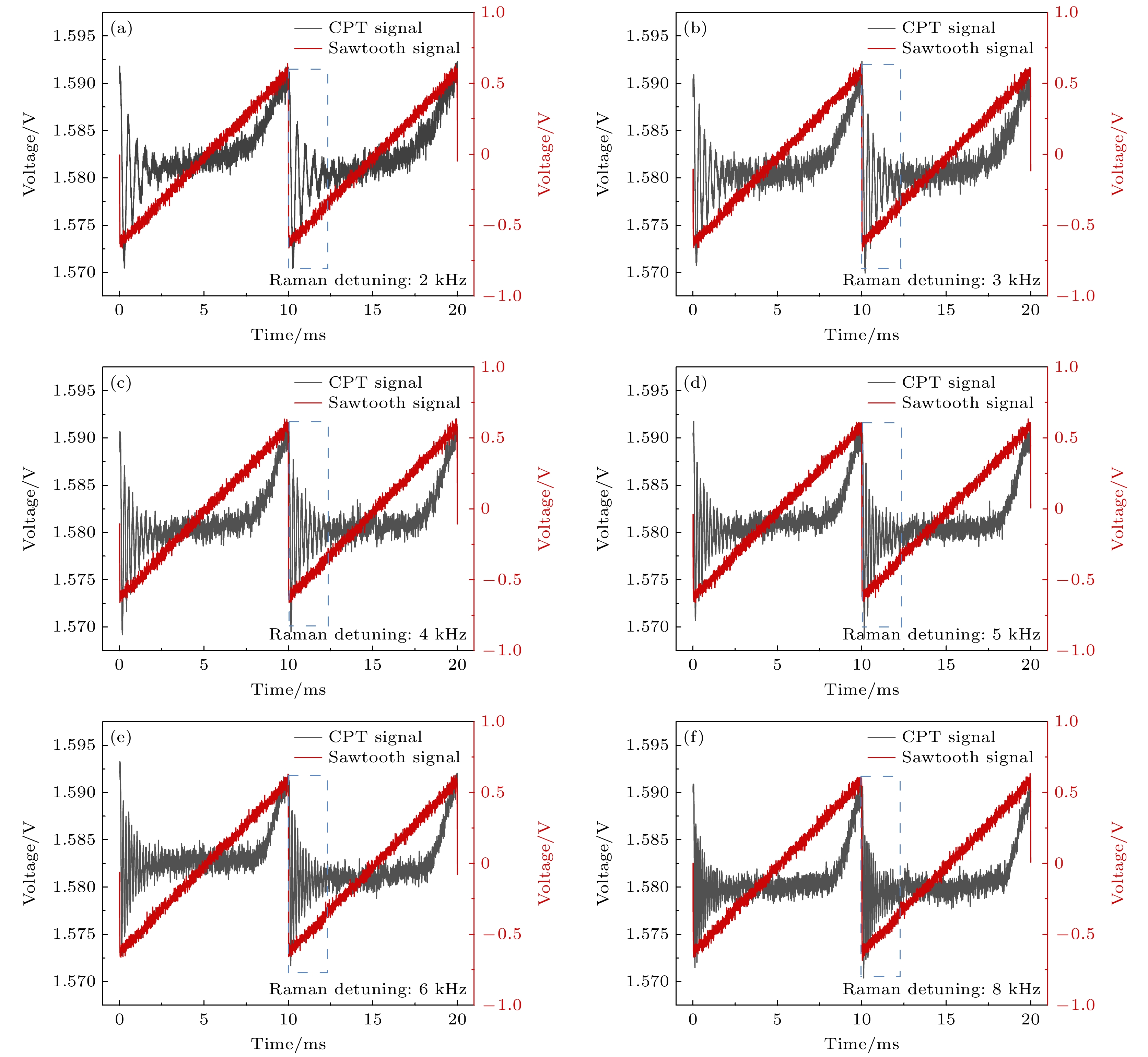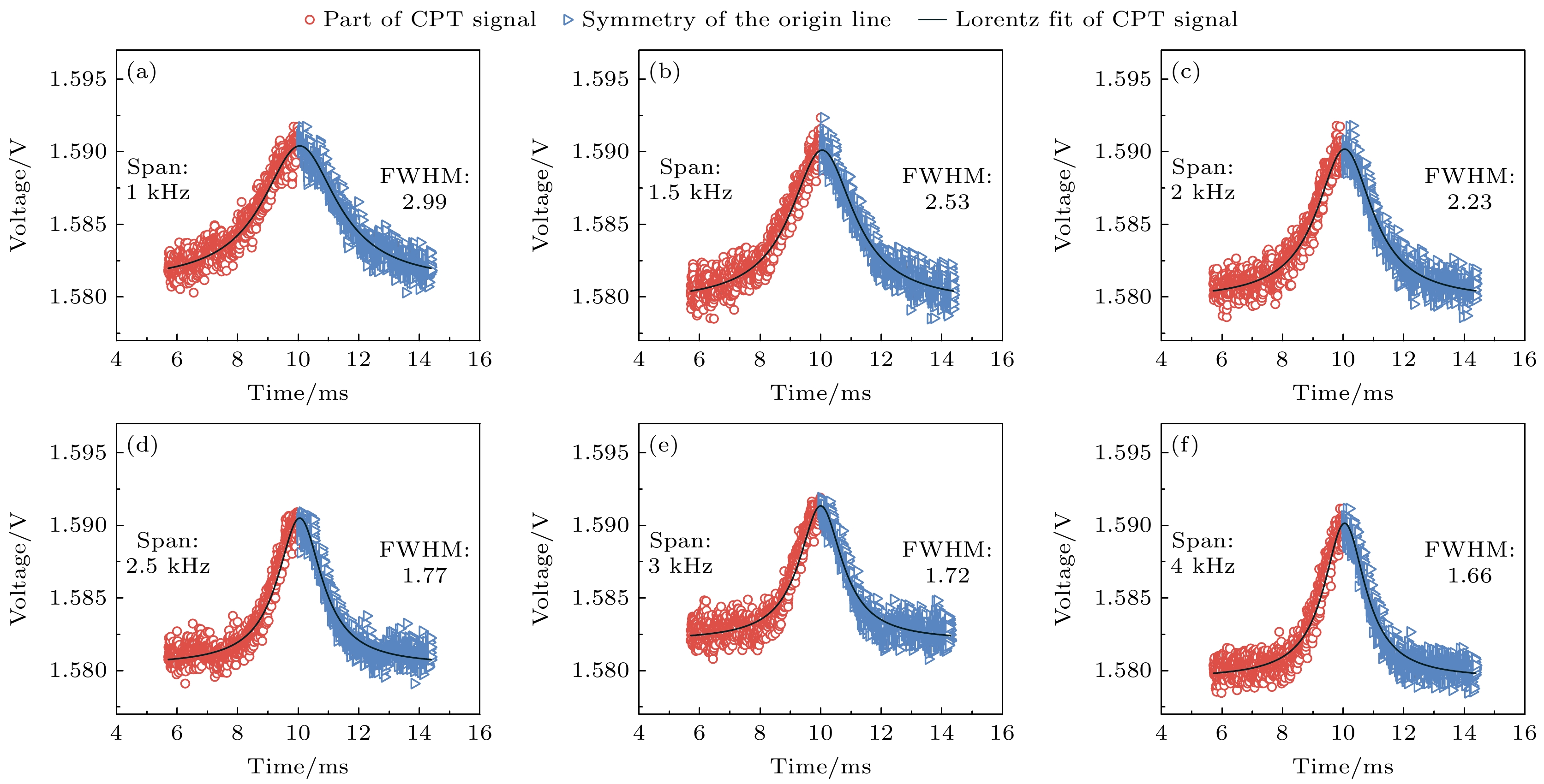-
相干布居囚禁(CPT)振荡是一种基于CPT态而产生的瞬态振荡现象, 与相干双色光频差和Λ型三能级结构原子基态能级间隔之间的拉曼失谐有关. 本文采用锯齿波对微波信号进行频率调制, 实现拉曼失谐均匀变化和阶跃变化. 并通过建立频率调制速率和拉曼失谐变化速率之间的关系, 分析拉曼失谐变化速率和变化方式对CPT振荡的影响. 结果表明, 当拉曼失谐均匀变化时, 激发CPT态原子产生振荡现象需要满足变化速率较快的条件, 且激发产生的振荡呈现非谐波振荡行为. 当拉曼失谐发生阶跃变化时, 激发产生的CPT振荡为阻尼振荡且振荡频率与失谐量相等. 利用锯齿波进行微波频率调制, 进而实现对拉曼失谐的调制, 实现CPT态的完全建立和CPT振荡的完全衰减过程, 在弱磁场测量和原子钟领域具有较大的应用潜力.Coherent population trapping (CPT) oscillation is a transient oscillation phenomenon based on the CPT effect, which is related to the Raman detuning of the coherent bichromatic laser fields from the hyperfine ground-states of three-level Λ system. In this work, sawtooth wave is adopted to modulate the frequency of microwave signal to make Raman detuning change uniformly and stepping. Meanwhile, by building the relationship between the microwave frequency modulation rate and the change rate of Raman detuning, the effects of the change rate and mode of Raman detuning on CPT oscillation are analyzed respectively. The results reveal that when the Raman detuning changes uniformly, the CPT oscillation will occur on condition that the change rate is high enough, and the excited oscillations show non-harmonic oscillation behavior. When the Raman detuning is triggered off by step change, the excited CPT oscillation is a damping oscillation, and the oscillation frequency is equal to the frequency of Raman detuning. The modulation of Raman detuning is realized by using sawtooth wave to modulate the microwave frequency, and then the complete establishment of CPT state and the complete attenuation of CPT oscillation process are achieved. This work presents a new modulation method to realize the CPT oscillation, which shows great application potential in the field of weak magnetic measurements and atomic clocks.
-
Keywords:
- coherent population trapping /
- transient oscillation /
- Raman detuning /
- damping oscillation
[1] Andryushkov V, Radnatarov D, Kobtsev S 2022 Appl. Opt. 61 3604
 Google Scholar
Google Scholar
[2] Li X J, Shi Y, Xue H B, Ruan Y, Feng Y Y 2021 Chin. Phys. B 30 030701
 Google Scholar
Google Scholar
[3] Alzetta G, Gozzini A, Moi L Orriols G 1976 Nuovo Cimento B 36 5
 Google Scholar
Google Scholar
[4] Liu X C, Ru N, Duan J Y, Yun P, Yao M H, Qu J F 2022 Chin. Phys. B 31 043201
 Google Scholar
Google Scholar
[5] Kitching J 2018 Appl. Phys. Rev. 5 031302
 Google Scholar
Google Scholar
[6] Vanier J 2005 Appl. Phys. B 81 421
 Google Scholar
Google Scholar
[7] Shah V, Kitching J 2010 Adv. At. Mol. Opt. Phys. 59 21
 Google Scholar
Google Scholar
[8] Vanier J, Godone A, Levi F 1998 Phys. Rev. A 58 2345
 Google Scholar
Google Scholar
[9] Park S J, Cho H, Kwon T Y, Lee H S 2004 Phys. Rev. A 69 023806
 Google Scholar
Google Scholar
[10] Guo T, Deng K, Chen X Z, Wang Z 2009 Appl. Phys. Lett. 94 151108
 Google Scholar
Google Scholar
[11] 赵晓娜, 庄煜昕, 汪中 2015 物理学报 64 134203
 Google Scholar
Google Scholar
Zhao X N, Zhuang Y X, Wang Z 2015 Acta Phys. Sin. 64 134203
 Google Scholar
Google Scholar
[12] Khripunov S A, Radnatarov D A, Kobtsev S M, et al. 2016 Quantum Electron. 46 668
 Google Scholar
Google Scholar
[13] Kobtsev S, Radnatarov D, Khripunov S, et al. 2019 J. Opt. Soc. Am. B: Opt. Phys. 36 2700
 Google Scholar
Google Scholar
[14] Grewal R S, Pustelny S, Rybak A, Florkowski M 2018 Phys. Rev. A 97 043832
 Google Scholar
Google Scholar
[15] Sun Y J, Ren Y X, Xu Y F, Wang Z Y 2021 Opt. Laser Technol. 138 106903
 Google Scholar
Google Scholar
[16] Grewal R S, Pustelny S 2020 Phys. Rev. A 101 033825
 Google Scholar
Google Scholar
[17] Arimondo E, Orriols G 1976 Lett. Nuovo Cimento 17 333
 Google Scholar
Google Scholar
[18] Erhard M, Helm H 2001 Phys. Rev. A 63 043813
 Google Scholar
Google Scholar
[19] Dan L, Fan Y Y, Zhuang Y X, Wang Z, Zhao J Y 2020 EPL 130 60004
 Google Scholar
Google Scholar
[20] Boller K J, Imamoglu A, Harris S E 1991 Appl. Rev. Lett. 66 2593
 Google Scholar
Google Scholar
[21] Shwa D, Katz N 2014 Phys. Rev. A 90 023858
 Google Scholar
Google Scholar
-
图 6 不同拉曼失谐均匀变化速率条件下, CPT态建立过程所得信号拟合 (a) 扫描宽度为1 kHz; (b) 扫描宽度为1.5 kHz; (c) 扫描宽度为2 kHz; (d) 扫描宽度为2.5 kHz; (e) 扫描宽度为3 kHz; (f) 扫描宽度为4 kHz
Fig. 6. The CPT signals excited by different change rate of Raman detuning: (a) The scan span is 1 kHz; (b) the scan span is 1.5 kHz; (c) the scan span is 2 kHz; (d) the scan span is 2.5 kHz; (e) the scan span is 3 kHz; (f) the scan span is 4 kHz
表 1 微波频率调制参数
Table 1. The modulation parameters of experiments.
序号 微波中心
频率/GHz频率偏移/kHz 扫描宽度/kHz 拉曼失谐/kHz (a) 3.417339564 0.50 1.0 2 (b) 3.417339314 0.75 1.5 3 (c) 3.417339064 1.00 2.0 4 (d) 3.417338814 1.25 2.5 5 (e) 3.417338564 1.50 3.0 6 (f) 3.417338064 2.00 4.0 8 -
[1] Andryushkov V, Radnatarov D, Kobtsev S 2022 Appl. Opt. 61 3604
 Google Scholar
Google Scholar
[2] Li X J, Shi Y, Xue H B, Ruan Y, Feng Y Y 2021 Chin. Phys. B 30 030701
 Google Scholar
Google Scholar
[3] Alzetta G, Gozzini A, Moi L Orriols G 1976 Nuovo Cimento B 36 5
 Google Scholar
Google Scholar
[4] Liu X C, Ru N, Duan J Y, Yun P, Yao M H, Qu J F 2022 Chin. Phys. B 31 043201
 Google Scholar
Google Scholar
[5] Kitching J 2018 Appl. Phys. Rev. 5 031302
 Google Scholar
Google Scholar
[6] Vanier J 2005 Appl. Phys. B 81 421
 Google Scholar
Google Scholar
[7] Shah V, Kitching J 2010 Adv. At. Mol. Opt. Phys. 59 21
 Google Scholar
Google Scholar
[8] Vanier J, Godone A, Levi F 1998 Phys. Rev. A 58 2345
 Google Scholar
Google Scholar
[9] Park S J, Cho H, Kwon T Y, Lee H S 2004 Phys. Rev. A 69 023806
 Google Scholar
Google Scholar
[10] Guo T, Deng K, Chen X Z, Wang Z 2009 Appl. Phys. Lett. 94 151108
 Google Scholar
Google Scholar
[11] 赵晓娜, 庄煜昕, 汪中 2015 物理学报 64 134203
 Google Scholar
Google Scholar
Zhao X N, Zhuang Y X, Wang Z 2015 Acta Phys. Sin. 64 134203
 Google Scholar
Google Scholar
[12] Khripunov S A, Radnatarov D A, Kobtsev S M, et al. 2016 Quantum Electron. 46 668
 Google Scholar
Google Scholar
[13] Kobtsev S, Radnatarov D, Khripunov S, et al. 2019 J. Opt. Soc. Am. B: Opt. Phys. 36 2700
 Google Scholar
Google Scholar
[14] Grewal R S, Pustelny S, Rybak A, Florkowski M 2018 Phys. Rev. A 97 043832
 Google Scholar
Google Scholar
[15] Sun Y J, Ren Y X, Xu Y F, Wang Z Y 2021 Opt. Laser Technol. 138 106903
 Google Scholar
Google Scholar
[16] Grewal R S, Pustelny S 2020 Phys. Rev. A 101 033825
 Google Scholar
Google Scholar
[17] Arimondo E, Orriols G 1976 Lett. Nuovo Cimento 17 333
 Google Scholar
Google Scholar
[18] Erhard M, Helm H 2001 Phys. Rev. A 63 043813
 Google Scholar
Google Scholar
[19] Dan L, Fan Y Y, Zhuang Y X, Wang Z, Zhao J Y 2020 EPL 130 60004
 Google Scholar
Google Scholar
[20] Boller K J, Imamoglu A, Harris S E 1991 Appl. Rev. Lett. 66 2593
 Google Scholar
Google Scholar
[21] Shwa D, Katz N 2014 Phys. Rev. A 90 023858
 Google Scholar
Google Scholar
计量
- 文章访问数: 5659
- PDF下载量: 173
- 被引次数: 0














 下载:
下载:







